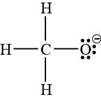
Concept explainers
Draw a Lewis structure for each ion.
a.
(a)
Interpretation: The Lewis structure for
Concept Introduction: Lewis structures are electron dot representations for molecules. These structures show the bonding between the atoms or molecules and the lone pairs of electrons. The arrangement of valence electrons among the atoms in a molecule is represented by its Lewis structure.
Answer to Problem 1.7P
The Lewis structure for
Explanation of Solution
In the given molecular formula,

Figure 1
The total valence electrons in
The bonds and lone pairs are added to form

Figure 2
The Lewis structure for
(b)
Interpretation: The Lewis structure for
Concept Introduction: Lewis structures are electron dot representations for molecules. These structures show the bonding between the atoms or molecules and the lone pairs of electrons. The arrangement of valence electrons among the atoms in a molecule is represented by its Lewis structure.
Answer to Problem 1.7P
The Lewis structure of
Explanation of Solution
In the given molecular formula,
![]()
Figure 3
The total valence electrons in
The bonds and lone pairs are added to form
![]()
Figure 4
The Lewis structure for
![]()
Figure 5
The Lewis structure of
(c)
Interpretation: The Lewis structure for
Concept Introduction: Lewis structures are electron dot representations for molecules. These structures show the bonding between the atoms or molecules and the lone pairs of electrons. The arrangement of valence electrons among the atoms in a molecule is represented by its Lewis structure.
Answer to Problem 1.7P
The Lewis structure of
Explanation of Solution
In the given molecular formula,

Figure 6
The total valence electrons in
The bonds and lone pairs are added to form

Figure 7
The Lewis structure of
(d)
Interpretation: The Lewis structure for
Concept Introduction: Lewis structures are electron dot representations for molecules. These structures show the bonding between the atoms or molecules and the lone pairs of electrons. These structures can be drawn for any covalently bonded molecules.
Answer to Problem 1.7P
The Lewis structure of
Explanation of Solution
The given molecular formula,

Figure 8
The total valence electrons in
The bonds and lone pairs are added to form

Figure 9
The Lewis structure of
Want to see more full solutions like this?
Chapter 1 Solutions
Organic Chemistry
Additional Science Textbook Solutions
Campbell Biology (11th Edition)
HUMAN ANATOMY
Physics of Everyday Phenomena
Biology: Life on Earth (11th Edition)
Essentials of Human Anatomy & Physiology (12th Edition)
- (12) Which one of the following statements about fluo- rometry is FALSE? a) Fluorescence is better detected at 90 from the exci- tation direction. b) Fluorescence is typically shifted to longer wave- length from the excitation wavelength. c) For most fluorescent compounds, radiation is pro- duced by a transitionarrow_forwardDon't used Ai solutionarrow_forwardDon't used Ai solutionarrow_forward
- Don't used Ai solutionarrow_forwardIndicate the correct option.a) Graphite conducts electricity, being an isotropic materialb) Graphite is not a conductor of electricityc) Both are falsearrow_forward(f) SO: Best Lewis Structure 3 e group geometry:_ shape/molecular geometry:, (g) CF2CF2 Best Lewis Structure polarity: e group arrangement:_ shape/molecular geometry: (h) (NH4)2SO4 Best Lewis Structure polarity: e group arrangement: shape/molecular geometry: polarity: Sketch (with angles): Sketch (with angles): Sketch (with angles):arrow_forward
- 1. Problem Set 3b Chem 141 For each of the following compounds draw the BEST Lewis Structure then sketch the molecule (showing bond angles). Identify (i) electron group geometry (ii) shape around EACH central atom (iii) whether the molecule is polar or non-polar (iv) (a) SeF4 Best Lewis Structure e group arrangement:_ shape/molecular geometry: polarity: (b) AsOBr3 Best Lewis Structure e group arrangement:_ shape/molecular geometry: polarity: Sketch (with angles): Sketch (with angles):arrow_forward(c) SOCI Best Lewis Structure 2 e group arrangement: shape/molecular geometry:_ (d) PCls Best Lewis Structure polarity: e group geometry:_ shape/molecular geometry:_ (e) Ba(BrO2): Best Lewis Structure polarity: e group arrangement: shape/molecular geometry: polarity: Sketch (with angles): Sketch (with angles): Sketch (with angles):arrow_forwardDon't used Ai solutionarrow_forward
 Chemistry & Chemical ReactivityChemistryISBN:9781337399074Author:John C. Kotz, Paul M. Treichel, John Townsend, David TreichelPublisher:Cengage Learning
Chemistry & Chemical ReactivityChemistryISBN:9781337399074Author:John C. Kotz, Paul M. Treichel, John Townsend, David TreichelPublisher:Cengage Learning Chemistry: Principles and ReactionsChemistryISBN:9781305079373Author:William L. Masterton, Cecile N. HurleyPublisher:Cengage Learning
Chemistry: Principles and ReactionsChemistryISBN:9781305079373Author:William L. Masterton, Cecile N. HurleyPublisher:Cengage Learning Chemistry & Chemical ReactivityChemistryISBN:9781133949640Author:John C. Kotz, Paul M. Treichel, John Townsend, David TreichelPublisher:Cengage Learning
Chemistry & Chemical ReactivityChemistryISBN:9781133949640Author:John C. Kotz, Paul M. Treichel, John Townsend, David TreichelPublisher:Cengage Learning Chemistry: Principles and PracticeChemistryISBN:9780534420123Author:Daniel L. Reger, Scott R. Goode, David W. Ball, Edward MercerPublisher:Cengage Learning
Chemistry: Principles and PracticeChemistryISBN:9780534420123Author:Daniel L. Reger, Scott R. Goode, David W. Ball, Edward MercerPublisher:Cengage Learning



